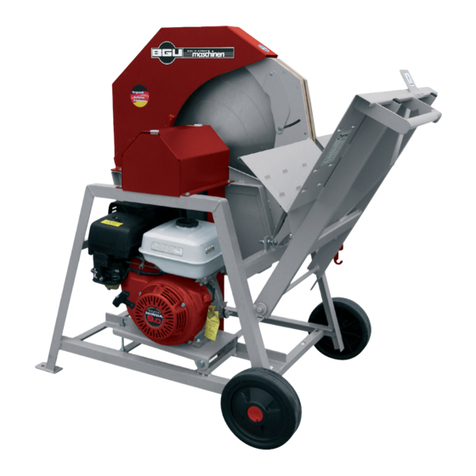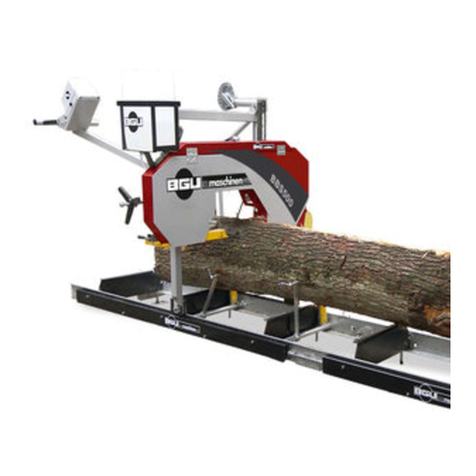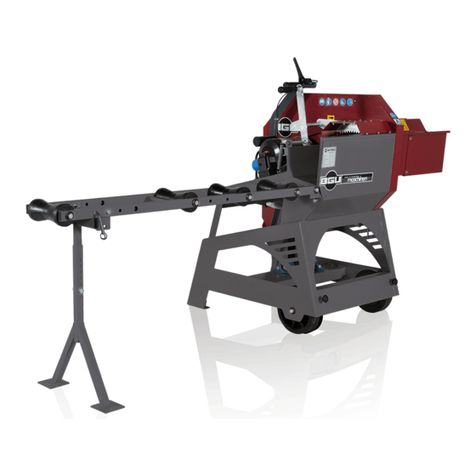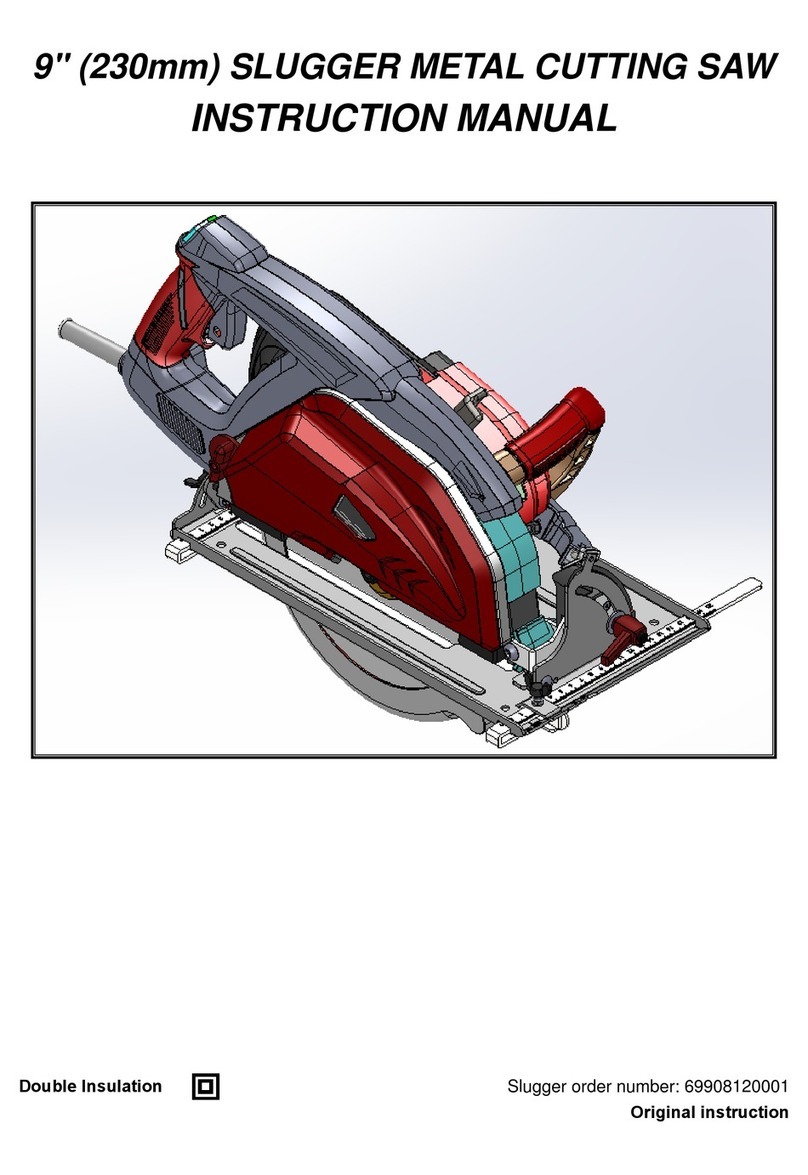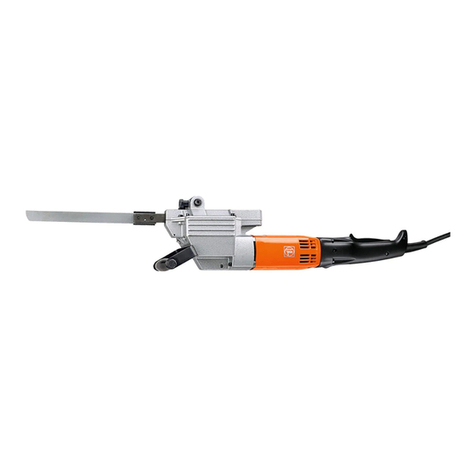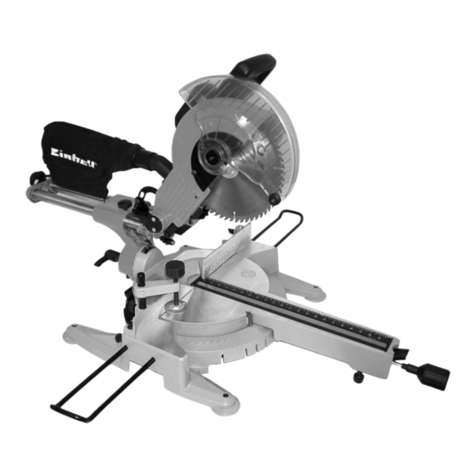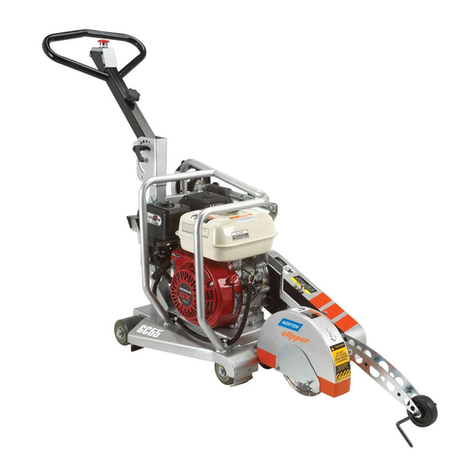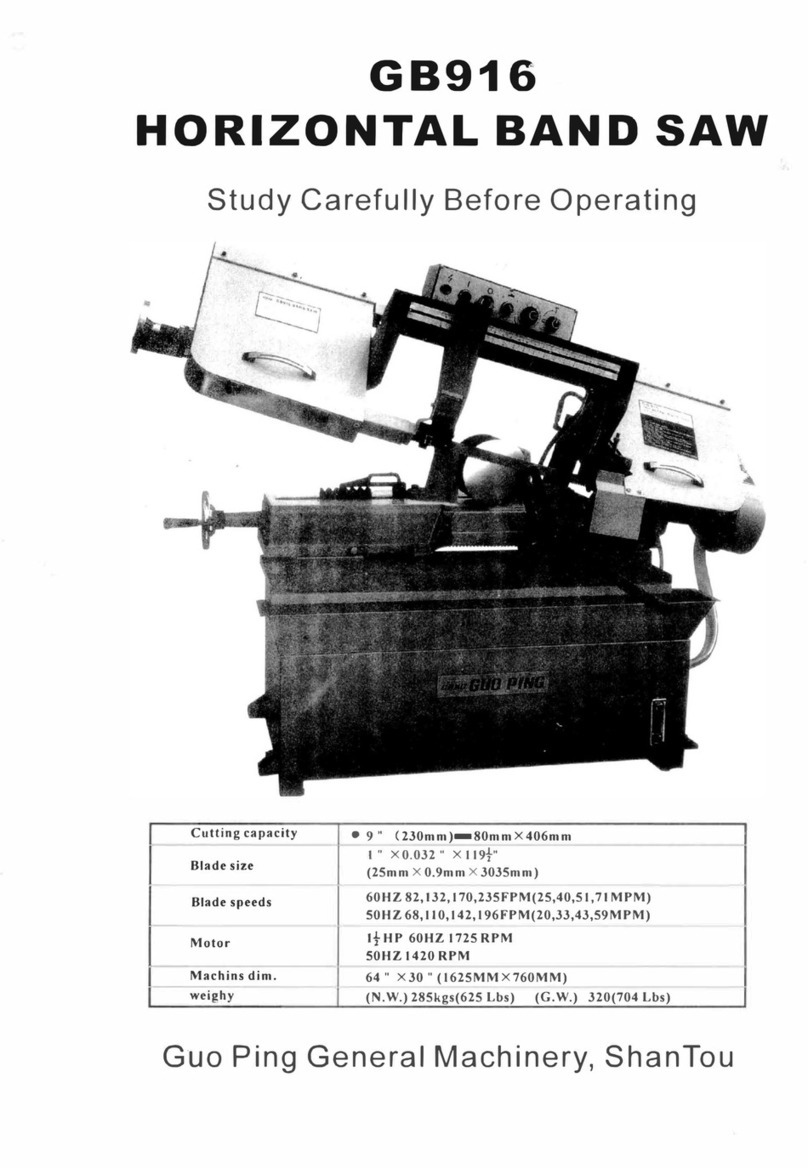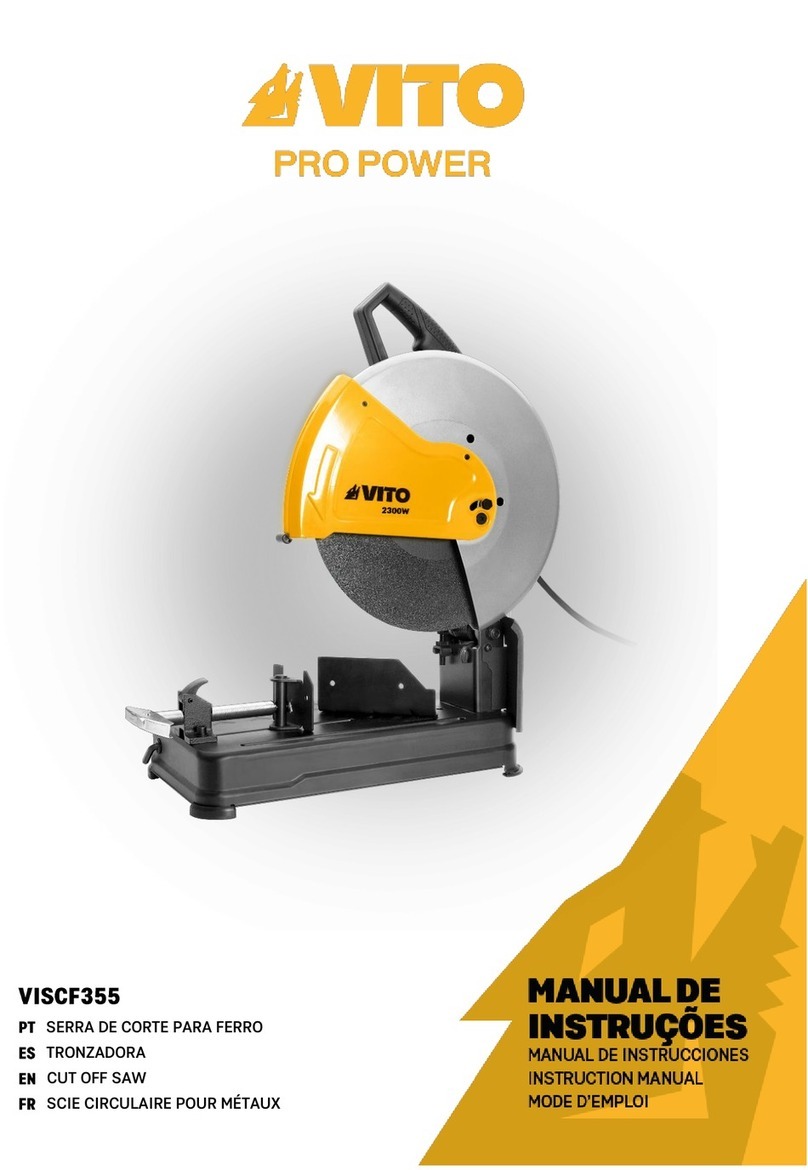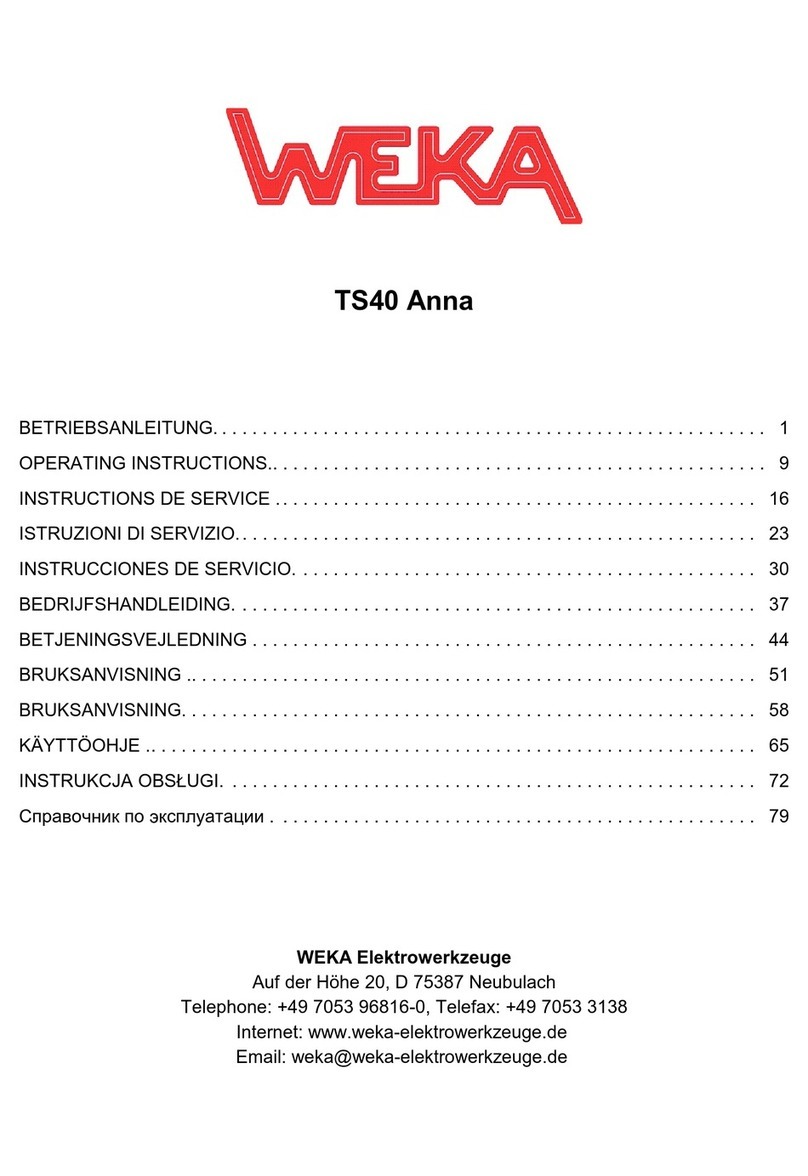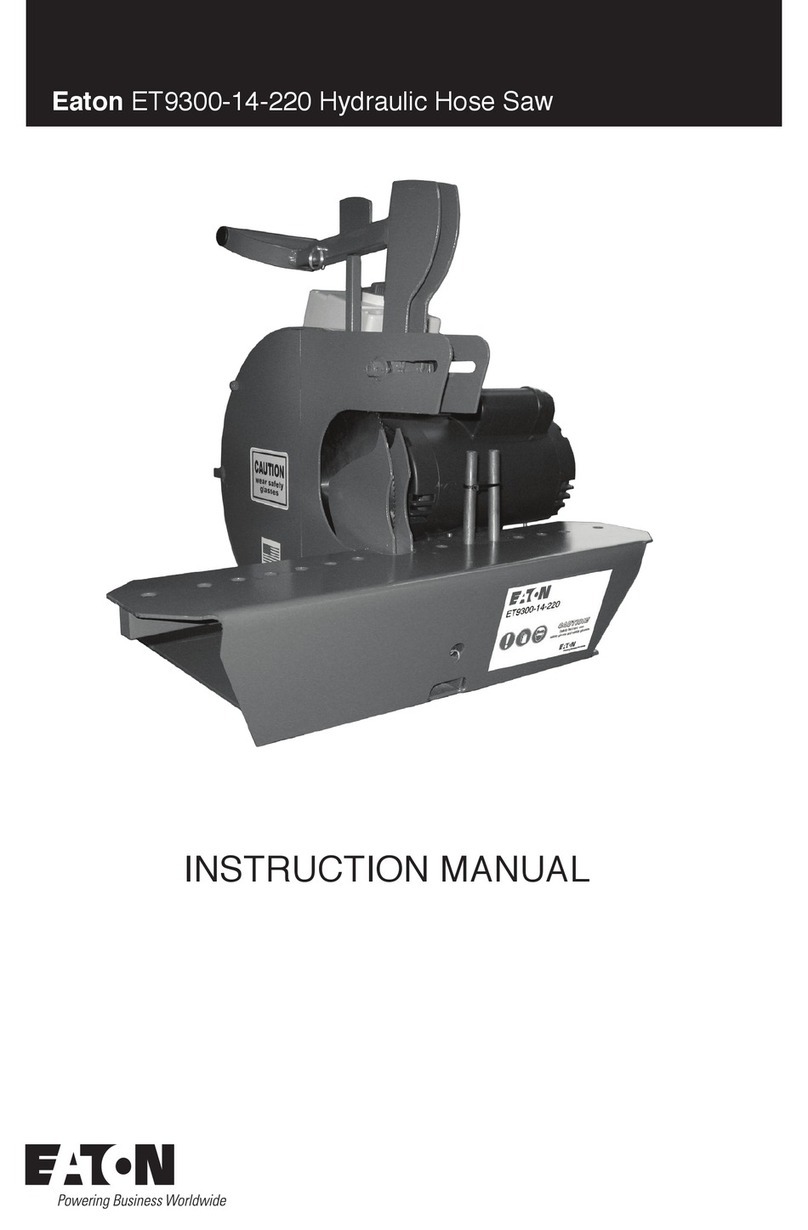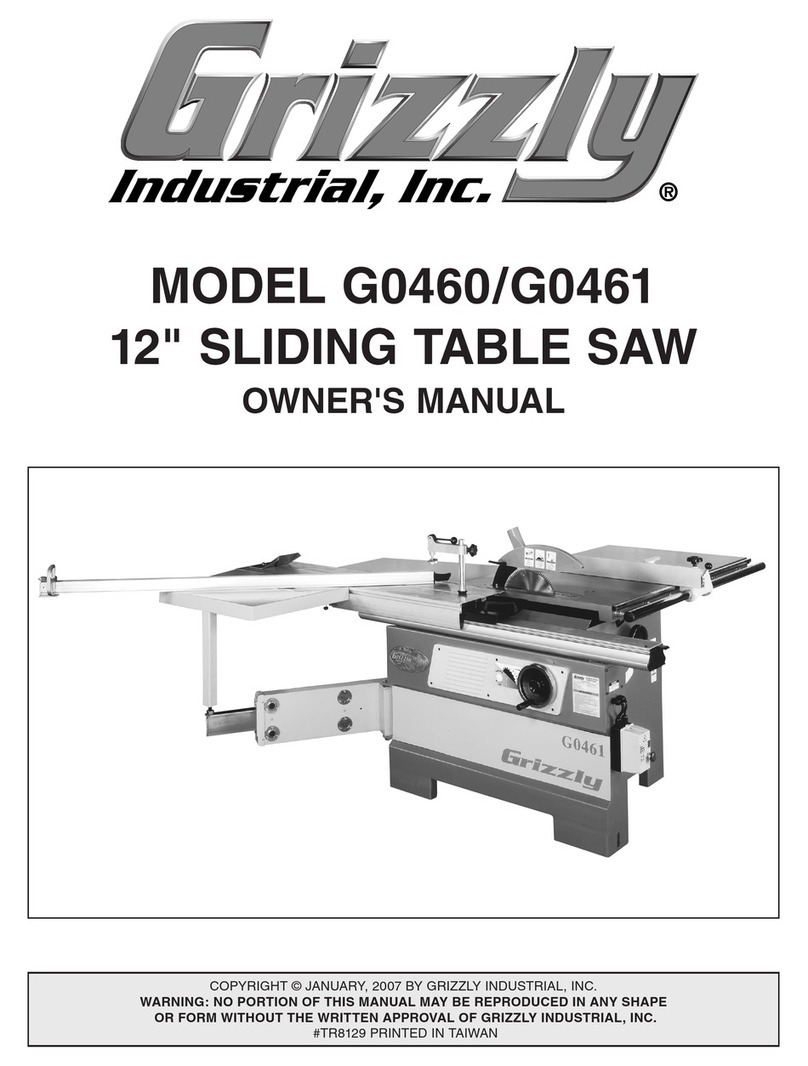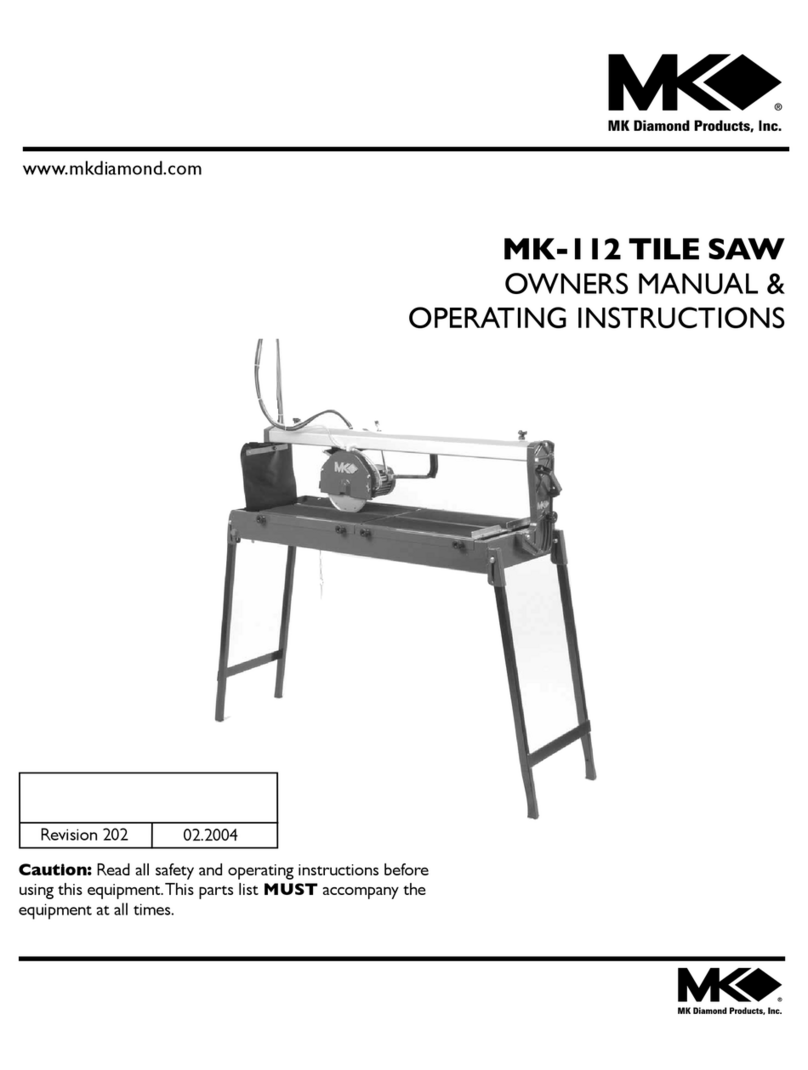BGU WK 790 R-2 User manual

USER‘S MANUAL
Carefully read these instructions
before starting and using your saw!
LOG CUTTING SAW
WK 790 R -2
Südharzer Maschinenbau GmbH
Helmestraße 94 ∙ 99734 Nordhausen/Harz
Zentrale: 03631/6297-0 ∙ -111
Internet: www.bgu-maschinen.de
e-mail: [email protected]
Made in
Germany
Set-up
& installation
Use
Maintenance
Accessories

2
CONTENT
1. General information 3
1.1 About this manual 3
1.2 Delivery and transport claims 3
2. Product overview 5
2.1 Log cutting saw with tilt-cradle and electric motor 5
3. Safty pictograms and warning labels 6
4. Safty 8
4.1 Safety rules about saw blade 9
4.2 Mandatory application field 9
5. Operating instructions 10
6. Repairs and maintenance 12
6.1 Ordinary maintenance 12
6.2 Cleaning after use 12
6.3 Replacing the saw blade 12
6.4 Tensioning and replacing the V-belt 13
6.5 Blade shaft bearings 13
6.6 Consumables 13
7. Transport 14
8. Dismounting and discarding an 14
obsolete machine 14
9. Technical specifications 15
9.1 Noise emissions 15
9.2 Electrical deployment system 16
10. Trouble-shooting chart 17
11. Other area of possible hazard 17
11.1 Mechanical dangers 17
11.2 Electrical dangers 17
12. Warranty 18
12.3 Environmental dangers 18
13. WK 790 R-2, spare part list 19
14. CE – Statement of Compliance 23

3
Dear customer,
thank you very much for your trust and preference in choosing our
equipment and joining the number of our best customers in the world.
This log cutting saw is available in the following variants:
WK 790 R-2 with belt drive
1.1 About this manual
Please take time to read this manual and learn to how operate and
maintain the saw safely.
For your easier reading this manual is laid out in several sections.
The sections are progressively numbered 1 through 14 and listed on
the “content” page.
The information, pictures and technical data in this document reflect
current or planned product features, functions, and characteristics as
of the publication date. Because of on-going product improvements
and feature additions, information in this document is subject to
change without notice.
If you are experiencing a problem or functional trouble on your ma-
chine, please read the “trouble-shooting” section to identify possible
causes and remedies. When you have checked all the possible causes
listed and you are still experiencing the problem, ask your Authori-
zed Service Centre for help.
When you order parts maintenance or repair services, your Authorized
Service Centre, your dealer or eventually the manufacturer need your
machine serial number and engine serial number. These are the num-
bers that you have recorded on the product identification label of the
manufacturer on the machine.
1.2 Delivery and transport claims
Upon delivery of the machine please check for visual machine dama-
ges such as damaged packing or scratched buckled parts. If so, make
a remark on all copies (including your own) of the delivery bill before
signing for acceptance.
Should your shipper or the truck driver refuse to accept your
claim, fully reject delivery and make sure to inform us (the manufac-
turer) immediately. No claims shall be taken into account by the ship-
per or by the insurance company, if a reservation note is not made on
the delivery bill.
1. GENERAL INFORMATION

4
All transport damages must be notified within latest 2 days from de-
livery.
Therefore delivery must be collected and inspected within this term.
Later claims shall be disregarded.
In case of assumed but not visually clear transport damages make
sure to mark the following sentence on the delivery bill : „Reserved
delivery due to assumed transportation damages“.
Insurance and shipping companies act with extreme caution in case of
transport damages and sometimes refuse to accept responsibility.
Please make sure to provide clear and exhaustive evidence (photos)
of the claimed damages.
Thank you in advance for your help and understanding in this matter.

5
Upper hood
Wheels
Log carriage
Saw blade
2. PRODUCT OVERVIEW
Grip handle
2.1 Log cutting saw with tilt-cradle and electric motor
Motor
Blade shaft
Steel stand
ON/OFF Switch

6
1. Warning label
„Do not operate the machine indoors!“
Never run the machine inside a closed area.
Exhaust fumes are toxic!
2. Safety pictogram
„Wear ear plugs and goggles!“
Loud noise can cause impairment or loss of hearing, wear a sui-
table protective device such as ear plugs and safety goggles.
3. Safety pictogram
„Direction arrow“
Motor, PTO shaft and driveline must be turning in the same direction
as shown by this arrow.
4. Safety-alert symbol
Read and recognize safety information. Be alert to the potential for
personal injury when you see this safety-alert symbol.
5. Identifi cation label
Product identifi cation. This label shows the company details of the
manufacturer and the main machine technical data.
6. “BGU-maschinen” Manufacturer’s logo.
7. Personal protection sign
„Mind these instructions!“
3. SAFETY PICTOGRAMS AND WARNING LABELS

7
8. Personal protection sign
„Before operating read operator‘s manual and
safety instructions!“
To avoid personal injury or death, carefully read and understand all
instructions pertaining to the saw including the engine manufacturer’s
operating and main tenace instruction manual.
9. Machine safety label
"Wear suitable protective boots!"
10. Machine safety label
"Wear suitable protective gloves!"
11. Operation safety label
„Before setting-up, servicing, maintaining and cleaning the machine,
disengage all power and stop the engine.“
This label warns users to fi rst disconnect power and wait till all mo-
ving parts have come to a complete stop before starting to clean or
maintain the machine. MIND THE SAW BLADE, WHILE OPERATING!
12. Operation safety label
Read, understand, and follow all instructions in this manual and on
the saw before starting! Always keep at safe distance from moving
parts.

8
Strictly perform installation, set-up, maintenance, cleaning
and transportation with the motor switched off and the blade
firmly secured against accidental operation.
Immediately disconnect power off the machine in case of any
eventual fault or trouble.
The user shall strictly comply with these operation, set-up, mainte-
nance, repair and trouble-shooting instructions in order to assure safe
operation and no damages to the equipment. Moreover we recom-
mend to let the machine be run only and strictly by trained and skilled
staff who must be familiar with the applicable occupational safety and
health administration rules as well as applicable transportation rules.
Incorrect use of the saw can cause serious injury or death.
No person under school leaving age should operate a circular saw.
Those who have reached school leaving age but are below the age of
16 may operate a circular saw if supervised by a competent person of
18 years or over. The machine shall be installed and kept in a suitable
location selected by the customer for safest operation.
The working area around the machine must be kept as clear as pos-
sible from surrounding obstacles and slippery foundation floors should
be duly treated (do not use saw dust or wood ash for this purpose).
Make sure that the equipment stands on a safe stable foundation.
Do not allow within the hazardous zone any unauthorized thirds or
persons who are not familiar with the dangers related to use and ope-
ration of the machine. Allow no bystanders, especially children and
pets in the working area.
● Due and proper illumination of the working site must be provided at
all times.
● The saw blade must be duly sharpened for maximum performance-
and no recoil danger. Flash and chips must be removed off the
crown wheel.
● Damaged or buckled blades (very likely to break during operation)
should not be used.
● A skilled licensed electrician must be asked for any repair of the
electric system.
● Always wear suitable hearing (ear plugs or muffs) and eye protec
tion (goggles or safety glasses) while operating the machine.
● Ensure that a wide but confined area is available around the machi-
ne and assure maximum working freedom.
● Operators must wear steel toe safety shoes and snug-fitting tear-re-
sistant work cloths.
4. SAFETY

9
● No additional customised protections or tools should be provided on
board of the machine, other than the ones designed and supplied by
the manufacturer.
● Do not apply pressure (for instance by means of the wood stock)
against the blade to make it come to a quicker stop.
● The machine is not designed for indoor use (dust release).
● NEVER leave the machine unattended with the running motor.
● Before leaving the operator‘s station for any reason, stop the ma-
chine motor, disconnect power and secure the machine against acci-
dental operation.
4.1 Safety rules about saw blade
The unit is strictly designed for use with a 750mm (outer diameter)
blade.
Strictly use blades as per EN Standard 847-1.
Do not ever use worn out blades in need of sharpening.
Make sure that the blade shows good conditions, no damages, no
cracks, no buckling and no missing/broken teeth/bits.
Hard metal blades require special care and handling. Make sure that
the blade bits do not ever hit against hard surfaces (for example con-
crete floors), which might cause invisible bits damage.
Hard metal blades must be suitable to operate at 1800 revolutions per
minute.
4.2 Mandatory application field
These log-cutting saws are strictly designed for preparation of fire-
wood. All other applications are forbidden and considered as “misuse”.
The manufacturer is not liable for any damage or injury resulting from
misuse!
The machine is capable to handle wood stocks in diameter of 8 - 30
cm. Shrubs and tiny branches bundles must be loaded on the trough
and securely hold on both sides of the blade.
The machine is strictly conceived for ONE-MAN OPERATION ONLY.
Check the tension of the V-belt before first use and after the first 20
operation hours.
Misuse will completely void your warranty. The manufacturer
accepts no liability for personal injuries and damages to other
equipment caused by misusing the machine.

10
This log-cutting saw model WK 790 R-2 is specifically recommended
for stationary use in your yard.
A rugged all-steel construction assures longest machine life at any
operative condition.
This machine is specially designed to work with a 750 mm blade ap-
proved and manufactured to EN 847-1.
This version can be powered by its powerful electric motor with inbuilt braking
provisions or alternatively from the tractor by means of a cardan shaft.
Operating this electric version requires use of an EC 32 Amp socket
and neutral conductor grounding system. Always have a skilled elec-
trician connect the saw to the local power network. When you switch
the machine on make sure to check that the blade is mounted to rota-
te in the proper direction before cutting any material. The tool must
rotate against the operator, that is upwards towards the operator. If
not, immediately switch the polarity in the plug of main power cord
using a phase changer. If you don’t feel familiar with phase changing
ask a licensed electrician to reset the saw cord.
Now fasten the grip on the log carriage and push to smoothly tilt it
over towards and through the blade.
If you working with twisted or crooked logs make sure to load
the log on the carriage, so that the bolged or canted side of the
log is turned to the blade in order to avoid the log from tipping
over or jamming during cutting and consequent possible even
major damages to the blade.
Now fasten the grip on the log carriage and push to smoothly tilt it
over towards and through the blade.
NOTE: avoid excessive pressure on the carriage through the blade
while cutting. Excessive hold-down pressure may slow the blade down
and cause dangerous jamming!
When doing so avoid all jerky, bumpy movements that could lead to
risky and dangerous situations. Timber in maximum length of 1.1 m
must lay on the trough by the entire length with no projecting end.
After the first log is cut off the timber, let the carriage swing down to
start-position (wide opened) before advancing the remaining timber to
the blade and starting a new sawing cycle. If you try to feed the stock
forward and cut before the trough reaches back to start position, you
may run the risk of hitting the stock against the blade guard conse-
quently causing severe personal injuries and machine damages for
which the manufacturer carries no liability.
5. OPERATING INSTRUCTIONS
Fig. „Phase changer“

11
The WK790 R-2 model is provided with an inbuilt electronic braking
arrangement permitting the blade to come to a complete stop within
a max lag-time of 10 seconds after switching the motor off. Genera-
tion of a humming noise after the blade has come to a complete stop
is fully normal and due to trouble-less motor operation. Restarting
during braking is not possible. Wait approximately 1 minute before
restarting the machine after it was switched off. The machine is desi-
gned for a max number of 10 ON/OFF cycles per hour to avoid dama-
ges to electronic braking system.
DO NOT OPERATE THE MACHINE if the electronic braking sys-
tem is out of order.

12
6. REPAIRS AND MAINTENANCE
Figure 1: “Direction of blade
rotation”
Make sure that the machine is fully disconnected and all mo-
ving parts are secured before performing any maintenance/re-
pair work on the machine. In the event of any malfunctioning,
switch the machine off before trouble-shooting.
„Radial thrust bearings are to compensate the unavoidable pro-
duction-related range of tolerance. Lubrication of radial thrust
bearings is NOT required, as the thrust function is only used on-
ce at the time of assembly, which means that the existing lubri-
cant fi lm will remain on.“
6.1 Ordinary maintenance
The following tasks belong to ordinary maintenance works:
● Clean the machine from eventual residual wood, chips or dirt.
● Lubricate all moving parts.
● Grease all pivoting parts of the log carriage
6.2 Cleaning after use
Remove wood chips and saw dust produced and left on the machine
during work. Clean the log carriage assembly removing all wood rests.
6.3 Replacing the saw blade
Safety note ! Wear safety gloves - pinched hands danger.
Before replacing the blade make sure to disconnect the machine
from power (unplug the electric motor).
Following instructions apply for safe and proper blade replacement:
● Disconnect power off the machine (unplug power cord) and wait for
the blade to come to a complete stop
● Unscrew and remove the upper blade hood
●
Release and undo the fi xation bolt on the blade clamping fl ange using a
spanner to secure the blade fl ange on the motor side as you undo the nut
● Remove the clamping fl ange
● Pull the old blade off the shaft (make sure to wear tear-resistant
gloves. DANGER!)
● Fit the new blade on the shaft. Note direction of rotation. (see Fig. 1)
Log carriage
carr
Saw blade

13
● Mount the locking flange back on the blade shaft minding the right
position of the feather-key in the flange.
● Tighten the shaft nut to hold the flange securely in place! ATTENTI-
ON to assemble the new blace follow the sequence: blade, external
clamping flange, washer, fixation bolt.
● Refit the blade hood in the original position duly set and clamped.
Periodically check the quality of the saw cut. Make sure to have
your blade resharpened at the first sign of wear. Strictly have
your blade resharpened by a skilled grinding service.
6.4 Tensioning and replacing the V-belt
If you are operating a WK790 R-2, proper maintenance requires re-
tensioning of the belt after a certain number of operation hours.
To perform stretching of the V-belt, you need adjusting the special screw
after removig the v-belt cover and releasing the motor fixation mount.
Adjust the V-belt so that you can still provoke an approx. 10 mm of
deflection by applying one finger tip pressure (see figure 2 - Stret-
ching a V-belt).
Refit the belt casing and the motor mount back in place before opera-
ting the machine again.
Running the saw with a loose V-belt will cause increased wear and
shorten you belt life.
To replace the belt release the clamp-screws and remove the safety
guard from the V-belt drive area. Remove the old belts from the shea-
ves and fit the new ones on.
Make sure to refit the V-belt casing back in place before operating the
machine again.
6.5 Blade shaft bearings
If you are using a „WK 790 R-2“ model, you should be aware that alt-
hough the saw blade bearings are self-lubricating one, a certain ex-
tent of lubrication is still required.
To lubricate the bearings remove the guard on blade shaft. To do so,
release all 4 hex screw M6 and lift the guard up. Use a regular grea-
sing gun to perform bearings lubrication. Make sure to refit both cover
plates before working again.
6.6 Consumables
The machine is equipped with the following consumable parts for
which no warranty is given!
Circular saw blade (Part no. 95076 CR) ,(Part no. 95021 HM)
Wood strips (left:Part no. 56244, right: Part no. 56243)
V-belt (Part no.55127)
Fig. 2 - Tensioning of
the V-belt
Approx. 10 mm deflection load
Sheaves center distance

14
Log & timber cutting saws are light equipment that can be easily mo-
ved on short-distance by means of two caster wheels and an ergono-
mic, comfortable grip handle located on the chassis on the opposite
side as the log carriage. In order to avoid infringement of the clearan-
ce area around the machine, the grip handle is retractable (push/pull)
on the model WK 790 R-2.
Simply fasten the grip and lift the saw for safe and rapid hauling of
the machine. For safety reasons the grip handle should remain re-
tracted (or lifted-up) during work to avoid risk of tripping or entang-
lement.
7. TRANSPORT
When the machine is fully obsolete and cannot be of any longer use,
it should be duly dismounted ahead of discarding. Certain components
need deactivation and dismantling in order to assure that no further
use is made by other parties and that no worn out parts are recycled
for other applications.
During dismantle be alert for possible recyclable materials and com-
ponents that belong to differentiated waste collection procedures ap-
plicable in your country.
The manufacturer is not liable and undertakes no responsibility for
personal injuries or damages that may result from the recycling of
worn out machine parts and eventual re-use in other applications dif-
ferent than originally stated in this manual.
Dismantling procedure:
Take good note please: each and every dismantling task must be per-
formed by authorized service centres or trained skilled staff only!
• Pull the machine down into single components
• Lock and clamp all moving machine parts
• Deliver each single component only to authorized waste manage-
ment facilities
• Remove rubber and plastic parts from the machine that must be
separately disposed
Deactivated, clamped moving/driving parts and components are of no
further risk and danger.
Electric components must be separately disposed to avoid substantial
environmental threat. In the event of fire on the electric deployment
system of the machine, use of an explosion-proof extinguish system is
required (for example powder fire extinguishers).
8. DISMOUNTING AND DISCARDING AN
OBSOLETE MACHINE

15
Technical specifications WK 790 R-2
Max. timber diameter mm 300
Saw blade diameter mm 750/30
Motor power P1 S6 40% ED kW 9
Voltage U V 400
Power supply I A 11,5
Speed rpm 1480
Frequency Hz 50
Power cord cross-section mm2 2,5
Short circuit protection of the power net A 35
Domestic overload safety No-volt re-
lease switch
Dimensions with open carriage (start position)
Length mm 1120
Width mm 820
Height mm 1170
Weight kg approx. 225
A log clamp (Part nr. 91274) is available as an optional on request only. This
can be used to ensure a safer and firm holding of the log against the blade!
9. TECHNICAL SPECIFICATIONS
9.1 Noise emissions
The noise level was measured in compliance with the general rules
for establishment of noise and acoustic pollution of garden and agri-
cultural equipment on work sites as well as with other national stan-
dards for noise measurement. The applicable measuring parameters
were: Measurement on the machine front edge at 1600 mm height
and 400mm away from the blade on the right hand side, while pro-
cessing beech wood in the size of 80+/-5% of the admissible timber
diameter as per this instruction book.
Idle 86 db(A)
Max
speed
89 db(A)
Hearing protection is mandatory!
The above mentioned values are emission measurements and may not
be therefore assumed as for a safe work environment. Although there
is a relationship between noise emission and immission levels, this is
8. DISMOUNTING AND DISCARDING AN
OBSOLETE MACHINE
Fig. 3 „Log clamp“

16
not a sufficient basis to determine the extent of on-site required pro-
tection. There are a lot of other factors that can influence site work
and risk of injuries and namely: the actual site/buildings configura-
tion, the concomitant presence of other noise sources (for instance
other machines performing other works in the neighbourhood) etc...
The factors applied for determining safety of a workplace may also ve-
ry from one country to the other. We are reporting here the noise va-
lues detected in the facility of the manufacturer on order to allow the
user performing a better evaluation of the possible risk/disturbance .
9.2 Electrical deployment system
As for all electric tools and equipment we strongly recommend use of
a portable residual current device (PRCD), unless you already have a
residual current device (RCD) in your house assuring safety and pro-
tection up to max 0.03A nominal fault current.
BEWARE: only let expert skilled staff do electric repair/mainte-
nance works!
Fig. 3
Wiring diagram
WK 790 R-2
Components list:
1. Metal housing
2. Overload safety 19.8x0.58=12.08
3. Klibo switch & plug combination 460V w. additional contact
4. Circuit board f. braking system
5. Rotary switch
6. Motor

17
10. TROUBLE-SHOOTING CHART
The following section will detail procedures for checking your saw, should you
encounter a malfunction. Before setting, operating, cleaning, maintaining or
repairing the processor, read the manufacturer’s operating and maintenance
instruction manual.
Type of trouble Possible causes Remedies
The saw doesn‘t start - Power supply is missing
- Faulty switch/plug
- Connect to power supply
- Replace switch/plug
The machine starts but
the blade does not run.
- Locking flange of the blade
shaft is not tight
- V-belt slips
- Tighten both the screw and
the nut
- Tension the V-belt
Blade runs but in the
wrong direction
- Inverted phases - Change the polarity in the line
phase changer or in the switch
The blade keeps chopping
the log
- Stump blade - Sharpen or replace the blade
Buzzing motor - Braking system is engaged - Stop the saw and switch it on
again after approximately 1 min.
11. OTHER AREA OF POSSIBLE HAZARD
11.1 Mechanical dangers
Possible dangers related to machine moving parts (saw blade) are mi-
nimized by means of suitable safeties and protections that cannot be
dismounted unless special tools and equipment are used.
Do not attempt to remove or by-pass any of the machine inbuilt safe-
ties.
DANGER: removing or by-passing inbuilt machine safeties may result
into serious operator’s personal injuries.
11.2 Electrical dangers
All live electrical parts are duly grounded and isolated to prevent ac-
cidental contact and danger of electric shocks. Do not ever attempt
to remove or by-pass any of the inbuilt electric safeties, linings and
protections.
DANGER: removing an electrical safety or protection lining may result
into serious injuries caused by electric shock.

18
11.3 Environmental dangers
The machine is strictly designed for outdoor applications.
DANGER: do not operate the machine indoors to avoid risk of inha-
ling wood dust.
12. WARRANTY
All BGU machines are covered with warranty terms in accordance with
the law. Customers should promptly notify the manufacturer eventual
material or production claims on their detection. While asking for war-
ranty service, customer should show copy of their purchase invoice or
receipt. The warranty does not cover for faults due to natural wear,
temperature or weather agents as well as misuse, faulty installation
or set-up, improper operation and lubrication or acts of vandalism.
No warranty will be given on parts damaged by improper handling,
use and application. The manufacturer is further not responsible for
warranty service on machines used for other applications than men-
tioned in this manual, altered or modified by the customer or other
thirds, or overloaded. Never attempt to use an incomplete machine or
one fitted with unauthorized modification. Any modifications to your
machine can cause personal injuries, and will void your Warranty.
Consumable parts with a prescribed life (i.e. pulleys, tools and various
auxiliary materials) are excluded from the warranty as well as adjust-
ment, optimization and fine-setting or retrofitting works.

19
13. WK 790 R-2, SPARE PART LIST
A ( 1 : 3 )
B ( 1 : 3 )
C ( 1 : 3 )
A1
2,
55,43,38
3,
46,41,67,62,
65,48,35,58
4,
22,56,63
70,61
5,
49,35,58
7,
50,68,
36,59
8,
56,38,61,
52,69,60,55
9,
53,64,37
69,60
10,
20
11,
51,36,59
12,
49,58,20
13,14,15,
54,69,60,44,37,27
17,18,19,
21,66
26,34,47
28,40,32
29,39,31
6,
51,42,
68,59
33
B
16,
20,25
23,57,24
C
30,35,48,58
.
.
.

20
Pos.
Description (WK 790 R-2)
Part Nr.
DIN
Dimensions
1Steel stand assembly
27061
2Log carriage assembly
27103
3Upper blade hood assembly
27118
4Blade shaft assembly
27121
5Grip handle assembly
27125
6Blade shaft guard, complete assembly
27128
7V-belt cover, complete assembly
27133
8Motor plate, complete assembly
27137
9Motor
27140
10 Log stop, complete assembly
27095
11 Grip handle on log carriage
27091
12 Log carriage extension
27096
13 Locking plate f. log carriage
27141
14 Stop
27142
15 Stop f. log carriage
27143
16 Open-end spanner SW 48
22957
17 Wood strip, left
56534
18 Wood strip, right
56535
19 Wood strip, bottom right
56536
20 Star knob
51006
M8x20
21 Rosette washer
54507
10x3
22 Pedestal bearing
50712
23 Rubber metall shock absorber
53906
D25 H10 M6x18
24 Blind rivet nut
51618
25 Blind rivet nut
51983
26 Holder f. motor safety switch
54290
27 Compression spring
54656
3,6x36,4x187
28 Wheels
53280
29 Roller
27097
30 Chip protector
27117
31 Spring washer
51233
D16
32 Spring washer
51234
D20
33 Saw blade 750 (HM)
90076
34 Washer
51646
DIN 125-1 AA 5,3
Table of contents
Other BGU Saw manuals
